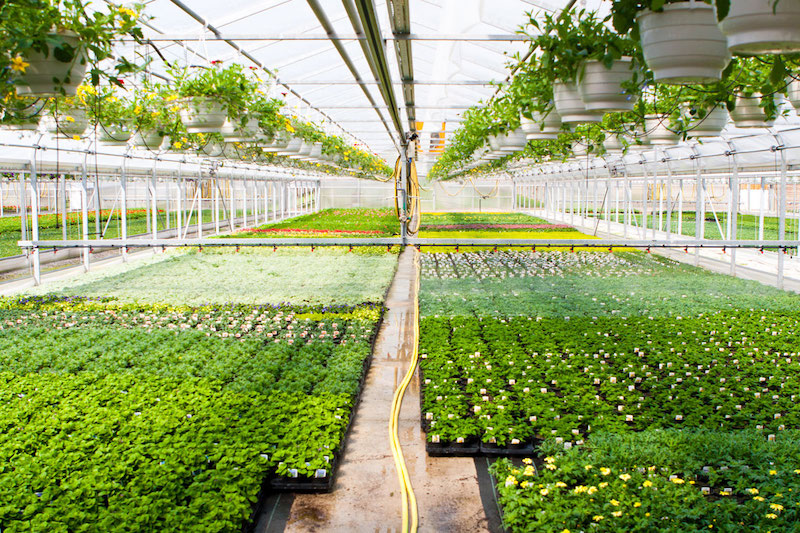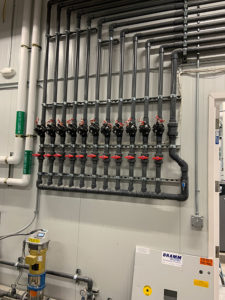
Maximizing Irrigation Efficiency
I haven’t kept track but I estimate that I’ve walked through more than a thousand growing facilities … greenhouses, nurseries, indoor vertical farms and field operations … over the past 35 years. I have been designing, supplying and supporting the environment systems — irrigation, water management and treatment, control and heating systems — for them for more than 30 years.
It has been a privilege to work with some of the best and most innovative growers on the planet and observe many of them contribute to the development of the best technologies available today, such as the development of flood floors; pressure compensated drip emitters; traveling irrigation booms; computerized irrigation; nutrient management systems; and more. My travels have allowed me to observe the best technologies and practices available, but also some of the crudest and least efficient ways of getting things done imaginable. In this article, I will address some of my observations regarding irrigation efficiency.
There are no alarming revelations here, just a summary of some key tools and factors to optimize the efficiency of an irrigation system. There is one observation however that may be a bit startling. I have observed, and read about, some growing facilities that waste as much as 50% (some I suspect even more) of their total irrigation water drawn from the source. That may include unnecessary use of reverse osmosis resulting in immediately dumping 25-40% of the incoming source water, failing to fix leaks, irrigation zones and delivery systems that do not match the crop, lack of control of irrigation decisions and timing, just plain old overwatering, overspray, and more.
Of course, there is also the matter of increasing pressure on water use efficiency brought on by droughts; water resource re-allocation due to climate change concerns; water pollution from irrigation runoff; loss of use of resources for wildlife preservation; and, in some areas, salt intrusion resulting from reduced aquifer levels. Lots of good reasons to make sure your irrigation systems are designed and operating at optimum efficiency.
Start at the Plant
Someone in the industry coined the term “plantcentric design” several years ago, which simply refers to designing systems with the needs of the plants being grown at the forefront. Sort of a version of form follows function engineering. Plantcentric design is more important than ever as average facility size and corresponding management challenges both get bigger. All irrigation system design should start at the plant, or crop level. What is the water budget for that crop, whether that is measured in milliliters or liters per plant per day, or liters per square foot, or gallons per acre per day? For monocrop facilities or monocrop zones, that means identifying the water required per plant/day for each stage of growth that will be grown in that zone. For example, a potted plant crop at 1.5 square foot per plant density in a 30 x 96 foot climate zone may demand 1.5 liters per plant per day for 1,920 plants, resulting in a total irrigation budget of 2,880 liters or 762 gallons per day (gpd) for that area.
Alternatively, a bedding plant grower may grow multiple types of crops in a year in the same zone. If that crop varies greatly in size, say propagation in early spring and poinsettias in the fall, this requires identifying both the minimum and maximum water demands in that zone and making sure the system is designed to provide efficient irrigation for both extremes. That result then is expressed in liters or milliliters per square foot of crop area instead of per plant. The minimum irrigation demand may be 0.5 liter/0.13 gallons to a maximum of as much as 1.5 liters/0.40 gallons per square foot per day.
Granular Irrigation Zoning

Once a water budget is determined for a particular area, it may be beneficial to divide that area into multiple smaller irrigation zones to allow maximum efficiency in irrigation control. This avoids irrigating two or more types of crops with different water demands, or worse yet a bare floor or bench, with the same amount of water and the same irrigation cycle frequency. Making a higher quantity of smaller irrigation zones reduces overwatering of one crop and/or underwatering of the other. Adding zones means more solenoid valves and PVC but that granularity pays off over time by increasing overall irrigation efficiency and improved plant quality.
Multiple Systems
Multiple types of plants, or multiple stages of the same plant growing in the same climate area also may require multiple irrigation delivery systems in the same area. Using the example of propagation in the spring and poinsettias in the fall, this may be a drip or flood floor system combined with an overhead watering boom and would provide efficient irrigation for both types of crops in a single climate zone. That 30 x 96 foot area may benefit by three or four drip irrigation zones and a single boom irrigator zone, or a single flood floor and single boom zone.
Consider the Source
Use the highest quality water to avoid using RO to remove excessive salts — and dumping 25-40% of the water right off the bat or having to implement a high leaching fraction to keep salt buildup in check. If your well water is not great, consider mixing it with or sole source rainwater (unless you are in Colorado, then don’t consider rainwater, please; surface water or RO if necessary but blended back with raw water to minimize waste).
Pulse Irrigation
This requires a good irrigation controller or computer system to execute but can reduce overall water delivery and unnecessary leachate by as much as 25%. A 2 liter per hour drip emitter requires a single 15-minute irrigation cycle to deliver an irrigation contribution of 0.5 liters. However, depending on the plant, pot size and growing media, running that for 15 minutes straight may result in channeling of the media and excessive leachate, or flooding the pot. Dividing that 15-minute cycle into two or three shorter cycles, dividing the irrigation cycle into the stages of soil wetting, absorption and saturation. This will often result in more uniform distribution in the pot and reduce undesired leaching. In some situations, it may also allow a slight reduction in the total irrigation time and water use.
Right-Sized Irrigation Delivery
Using two 4 liter per hour drip emitters or a 1 gpm overhead nozzle to water a crop of plants that require the application of a 0.5 liter per day will result in excessive leaching and water waste, in addition to waste of expensive nutrients. In flood irrigation systems, for example, most pot sizes and growing media combinations will take up 100% of the moisture they need and 70-80% of the moisture capacity of the pot within a few minutes of being flooded. Yet I continue to see flood cycles of 20 to 60 minutes in many flood systems resulting in wasted water, wasted nutrients and increased the plants susceptibility to root and foliar diseases.
Selecting the right sized delivery devices and systems also allows for a more efficient and often smaller and more flexible irrigation water management system (tanks, pumps, injectors, pipes, valves, etc.). It may also reduce the cost of treatment and filtration systems due to reduced volumes and flow rates.

Adequate Pressure and Flow
Oversizing of the delivery devices and systems is a problem. However, undersized systems are far more common, with an inadequate flow rate, pressure, or both. This is quite common simply due to the expanding nature of our industry. The pumps and piping that once were adequate for an acre are now being asked to service three acres or more. Inadequate flow and/or pressure result in poor and inefficient performance of downstream irrigation delivery systems. Fog and spray nozzles, drip emitters, and sprinklers do not deliver their specified flow rates or cover the same area they were designed to cover; the nozzle or sprinkler may emit large drips, causing damage to plants below; and irrigation cycle times may no longer be adequate or may require excessive time and resulting poor uniformity.
Irrigation distribution systems (pumps, pipes) should be sized to provide higher flow rates and higher pressures than the totals of the downstream demand. I like to size pumps and pipes for 25-30% over the calculated demand. This will compensate for clogged and sagging aging pipes, expected and unseen leaks, reduced capacity resulting from the wear-down of pump impellers, and, of course, those three or four extra bays or ground to grounds just added. It is also a good idea to allow installation space for the addition of another pump in the future to accommodate that expansion or additional demand in the future. A larger and longer pump manifold is cheap and allows an additional pump to be slid into place when needed.
Closed Loop Irrigation
There has been a continual rise in the use of closed loop irrigation systems as the industry expands and pressures increase to reduce runoff and be more efficient with water use. Closed loop irrigation systems can be a great way to address this. Flood irrigation systems, deep water culture (DWC) and nutrient film technique (NFT) systems all come in several flavors now. Traditional flood benches/tables, concrete flood floors, cascading concrete floors, gravel flood floors, cascade/flow troughs and unique hybrid combinations of two or more of these are readily available and allow the retention and reuse of up to 100% of irrigation water not taken up by the plants.
These systems are safe and proven. All drain water is captured, filtered, disinfected, reinjected with fertilizer to replace nutrients that have been taken up by the plants, and then pumped back out for the next irrigation cycle. Adequate attention to this requires an entire article … or book … of its own. Closed loop irrigation works great, but not for all crops or growing styles. Ask an irrigation professional for direction on suitability.
Irrigation Controls
Still one of my favorite subjects and, by my observation, still one of the least understood by many growers. Automate your irrigation. Go ahead — just do it and you will see the results. Automation involves more than just opening and closing solenoid valves. Many growers find it easy to turn over the opening and closing of valves to a control system. That control is great because Leroy the irrigator sometimes can’t run fast enough to turn on the next valve or waits too long to close the valve because he’s on his cell phone. Automation of irrigation also should include automating the decision of when to irrigate each zone, and the automation of pumping. Again, this deserves an article of its own, or a book, several of which have already been written so please Google those to learn more.
It will suffice to say that the major industry computer control manufacturers have perfected, or nearly perfected, this task and the choices in programs, control methods, sensors and usability have improved enormously over the past 30 years and will pay for themselves in nearly every size and type of growing operation.


 Video Library
Video Library 




















